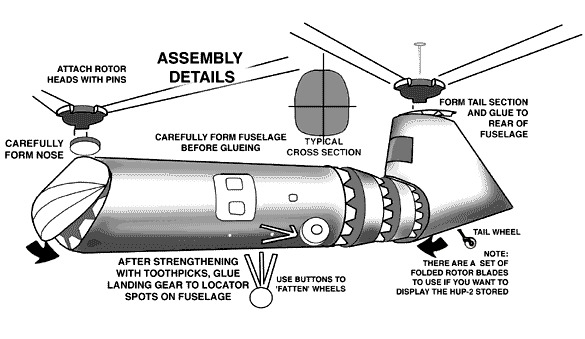
The HUP-2 Vertol Retriever Helicopter-US Navy
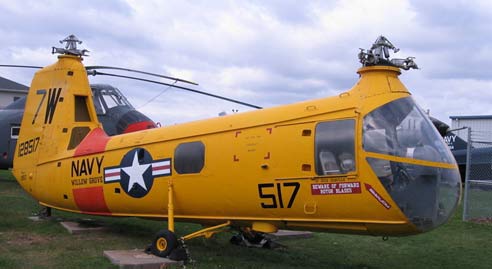
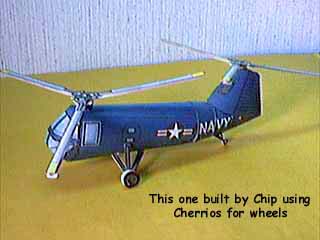
By the early 50's the engineers were just getting down to building a real functional helicopter and this is a good example, the Piasecki HUP 2.
When a plane went overboard, the Retriever was there hovering, and ready for the pickup. This little model should get some kind of reward for paper sculpture...all that in basically 4 pieces.
And even a set of folded rotors for displaying a stowed model
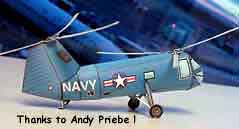
Piasecki (Vertol) HUP Retriever
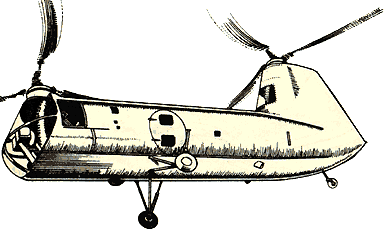 The twin-rotor helicopter was planned to a US requirement for a carrier borne
SAR, plane guard and transport helicopter. The original model was the HUP-1
with a 1525 hpl Continental 8-975 radial, endplate vertical surfaces
at the tips of the tail plane located on the sides of the rear rotor pylon,
and provision for five passengers or three litters in addition to the two-man
crew.
The twin-rotor helicopter was planned to a US requirement for a carrier borne
SAR, plane guard and transport helicopter. The original model was the HUP-1
with a 1525 hpl Continental 8-975 radial, endplate vertical surfaces
at the tips of the tail plane located on the sides of the rear rotor pylon,
and provision for five passengers or three litters in addition to the two-man
crew.
The HUP-2 was a generally improved model with more power, and was distinguishable from the HUP-1. The twin-rotor helicopter was planned to a US requirement for a carrier borne SAR, plane guard and transport helicopter. The original model was the HUP-1 with a 525 hp Continental R-975 radial, endplates vertical surfaces at the tips of the tailplane located on the sides of the rear rotor pylon, and provision for five passengers or three litters in addition to the two-man crew.
The HUP-2 was a generally improved model with more power, and was distinguishable from the HUP-1 by its lack of any tailplane/fin assembly. The type featured a hatch offset to starboard in the cabin floor through which a 400-lb rescue hoist could operate. Some 15 of the 165 HUP-2s were delivered to the Aeronavale, remaining in service into the 1960s as the service's standard plane guard and light vertical replenishment helicopter.
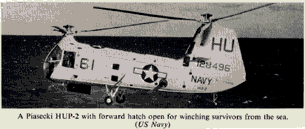 After trials with two prototype Model PV-14 XHJP-1 helicopters
for plane-guard and utility duties, the Navy ordered 32 similar PV-18 HUP-Is
with the 525 hp Continental R-975-34
engine and outrigger fins. Deliveries began in February 1949, and Squadron HU-2
received its first aircraft in January 1951.
After trials with two prototype Model PV-14 XHJP-1 helicopters
for plane-guard and utility duties, the Navy ordered 32 similar PV-18 HUP-Is
with the 525 hp Continental R-975-34
engine and outrigger fins. Deliveries began in February 1949, and Squadron HU-2
received its first aircraft in January 1951.
The 165 HUP-2s had an autopilot, no outer fins and 550 hp Continental R-975-42 engine. The HUP-2S had radar for anti-submarine duties. From the Army, the Navy acquired 50 HUP-3s with R-975-46A engines. The HUP-2 and HUP-3 models became UH-25B and UH-25C respectively in 1962.
Despite its excellent showing, the Piasecki helicopter suffered developmental troubles. Early in 1948, the first XHJP-1 crashed while hovering when a forward rotor blade shed its entire wooden cover. The craft was extensively damaged but nobody was hurt. This incident prompted Piasecki to redouble its efforts to develop metal rotor blades, as Hiller and Sikorsky had already done. Work was progressing on this front in the early 1950S when the Navy forced Piasecki to contract with the Prewitt Aircraft Company of Clifton Heights, Pennsylvania, for metal blades.
HJP was redesignated HUP, a change reflecting the Navy's logical decision to denote the utility role for helicopters by the letter u rather than j.
Prewitt did indeed create bonded-steel rotor blades for the HUP-2. Designed by former Kellett chief engineer Richard Prewitt, these blades had been in development under Navy contracts since 1947. Unfortunately, they were poorly designed and caused unacceptable vibration levels on HUPS. A waste of public and Piasecki money, they were not used operationally.
HUP fuselages were built at Philadelphia International Airport, where Piasecki had rented two new hangars from the city. The HUP engineering team and test pilots were moved to that location, on whose flight ramps newly completed HUP5 were tested. Dedicated as Plant in October 1949, this airport facility raised total company floor space to an impressive 125,000 square feet.
Work was already under way on an autopilot for hands-off flying and hovering. An autopilot was considered essential for the HUP because the Navy badly wanted to be able to fly it in instrument conditions. Short coupled and plagued with stability problems, HUPS were hard to fly (this notorious instability contributed to Ryan's unintentional loop). The company had already experimented with a variety of horizontal, vertical, and canted tail surfaces, but these problems defied an adequate solution.
The company approached the requirement for stability augmentation by testing Sperry, Minneapolis Honeywell, and Lear autopilots in the x~. Performed by company and military test pilots in 1950, these flight tests were the first ever performed of an autopilot in a helicopter. Although success was obtained in forward flight, the units were unable to stabilize the helicopter during hover.
Some success was eventually obtained with the Sperry A- 12 autopilot of World War II vintage, but it came too late for the HUP- I. As a result, the HUP-2 was the first production helicopter ever to feature an autopilot. Thus equipped, it dispensed with its predecessor's large tail surfaces. A number of crashes because of a severe hardcover failure mode would lead to this autopilot being removed in operational service.
The HUP- Retriever entered full Navy service in January 1951, and the HUP-2 the following year. Chronic engine problems soon led to the loss at sea of more than ten helicopters, although fortunately without loss of life or even serious injury. That these losses were through no fault of the Piasecki Helicopter Corporation was no consolation, for they threatened the viability of the entire HUP program. The original Wright R-975 had been a fine engine; as modified and uprated by Continental, however, it was no longer trustworthy.
When the many fixes proposed by Continental failed to provide a cure, it fell to Commander Pete Brown, the talented aeronautical engineer-cum-helicopter pilot then heading. Helicopter Class Desk, to come up with a workable solution. Brown observed that the carrier-based HUP-2 had a crew of two, a pilot and a crew chief. These machines stood by to retrieve the crews of airplanes that ditched following failed arrested landings. Since this "plane-guard" mission rarely called for more than two men to be plucked from the sea at one time, the helicopters were rarely being loaded to capacity.
Brown's idea was to lower the HUP'S gross weight by 1,000 pounds and derate its engine by 100 hp. These operational limits were immediately placed in effect and losses subsided to acceptable levels, allowing HUPS to operate successfully for the next decade. During that period, the operating limits were gradually phased out as engine improvements were implemented.
HUPs rescued thousands of people in operational use, including more than 10,000 civilians in Colombia during U.S. Navy flood relief in the mid-1950s. Because tandem rotor helicopters lack the sensitivity to wind direction that single-rotor types display, the BliP series further endeared itself to carrier skippers who could launch their Retrievers without turning their vessels into the wind.
In June 1954 the last of 339 production examples of this hardworking series was delivered. This successful production run, an impressive total for the day, had included an Army version of the HUP-2 known as the H-25A Mule, plus a limited number of fleet helicopters for the Canadian and French navies.
On the last day of 1954 the vastly improved HUP-4 flew for the first time. This prototype featured the reliable 7oo-hp Wright R-1300. Its substantial power increase would be fully exploited the next year when a companion development of an uprated transmission was completed. Had the HUP-4 been available sooner, it would have greatly extended the service life of the excellent HUP series. But the Navy canceled the whole program in frustration in 1955 and sponsored instead development of the HU2K-I Seasprite, the Kaman company's first single-rotor helicopter.
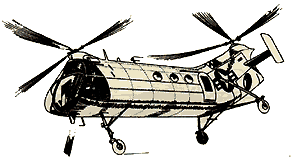
Specifications for the Piasecki HUP-3
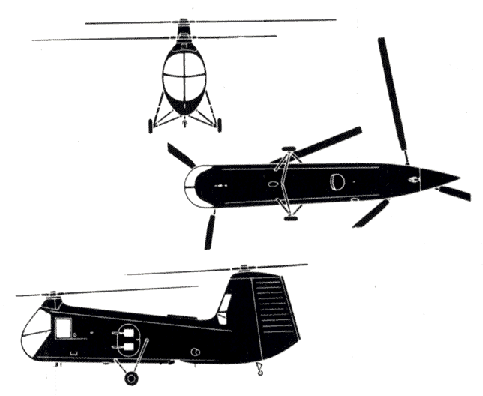 |
Crew: 2 pilots Capacity: 4 passengers Length: 56 ft 11 in Rotor diameter: 35 ft Height: 12 ft 6 in Disc area: 1,924 ft² Empty weight: 3,928 lb Loaded weight: 5,750 lb Max takeoff weight: 6,100 lb Powerplant: 1× Continental R-975-46A radial, 550 hp Performance Maximum speed: 105 mph Range: 340 mi Service ceiling: 10,000 ft Rate of climb: 100 ft/min Disc loading: 3 lb/ft² Power/mass: 0.09 hp/lb |



